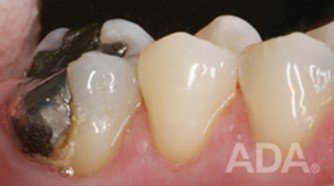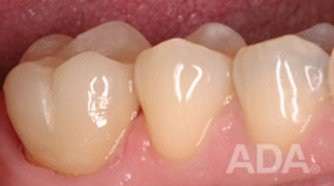Dental Crowns and Bridges
What Is a Crown?
A crown is a cover or "cap" your dentist can put over a tooth. The crown restores the tooth to its normal shape, size, and function. A crown can make the tooth stronger or improve the way it looks.
Why Do I Need a Crown?
You may need a crown if you:
• have a cavity that is too large for a filling
• have a tooth that is cracked, worn down, or otherwise weakened
• have had root canal treatment-the crown will protect the restored tooth
• want to cover a discolored or badly shaped tooth and improve your smile
What Is It Made from?
Crowns are made from several types of materials. Metal alloys, ceramics, porcelain, porcelain fused to metal, or composite resin may be used. When a crown is made, the material often is colored to blend in with your natural teeth.
Your dentist wants your crown to look natural and fit comfortably in your mouth
How Is a Crown Placed?
It usually takes two dental visits to complete the treatment. When a crown is placed over a natural tooth, several steps are involved:
- The dentist prepares the tooth by removing its outer portion so the crown will fit. Any decay is also removed. If additional tooth structure is needed to support the crown, the dentist may build up the core of the tooth.
- An impression is made to provide an exact model for the crown. The impression can be made from a mold or by digitally scanning the tooth.
- You will get a temporary crown while you wait for the permanent crown to be ready. This usually takes less than two weeks. While you have a temporary crown, the tooth may be sensitive to hot and cold. Avoid chewing gum and sticky foods during this time.\
- When the new crown is ready, the dentist places it in your mouth and makes the necessary adjustments. When you and your dentist are happy with how it looks and feels, the crown is cemented into place.
Caring for Your Teeth
Like natural teeth, crowns can break. And the tooth under the crown can still get cavities. To prevent cavities or damage to your crown:
- Brush your teeth twice a day and clean between your teeth once a day. Look for oral care products that have the American Dental Association's Seal of Acceptance, which tells you that they meet ADA standards for safety and effectiveness.
- Avoid chewing hard foods, ice, or other hard objects, such as pencils, especially if you have tooth-colored crowns.
- Be sure to see your dentist for regular exams and professional teeth cleanings. •
What Is a Bridge?
A bridge is a replacement tooth or teeth that fill the space where one or more teeth are missing. The bridge restores your bite and helps keep the natural shape of your face. Before you get a bridge, your dentist wants you to know more about the steps involved. He or she can advise which type of bridge is best for you.
Why Do I Need a Bridge?
A missing tooth is a serious matter. Teeth are made to work together. When you lose a tooth, the nearby teeth may tilt or drift into the empty space. The teeth in the opposite jaw may also shift up or down toward the space. This can affect your bite and place more stress on your teeth and jaw joints, possibly causing pain.
Teeth that have tipped or drifted are also harder to clean. This puts them at a higher risk for tooth decay and gum disease.
When a tooth is missing, the bone may shrink. If that happens, it may change the way the jawbone supports the lips and cheeks. Over time, this can make your face look older.
How Do I Replace a Tooth?
Placing a bridge usually takes more than one dental visit. On the first visit, your dentist prepares the teeth on both sides of the gap. He or she will later attach the bridge to these teeth.
Your dentist then takes an impression or an image of your teeth and the space and sends it to a dental laboratory. Technicians at the lab make the bridge. Your dentist will place a temporary bridge to protect your prepared teeth while you are waiting for the permanent bridge.
When the permanent bridge is ready, the dentist fits, adjusts and cements the bridge to the prepared teeth. This type of bridge is permanent and cannot be taken out of your mouth without a dentist's help.
Crown Used to Replace a Filling





